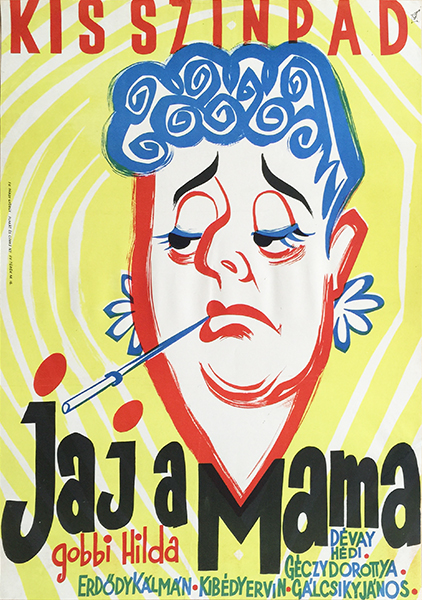
Description:
Colourful theatre poster from the 1960s. It advertised the play 'Jaj a Mama' (Oh, Mama!) with the outstanding Hungarian actress of the era, Hilda Gobbi.
The piece was played at 'Kis Színpad' (Little Stage), a former chamber theatre of 'Vidám Színpad' (Cheerful Stage). Kis Színpad was located in the downtown of Budapest, in Jókai square 10. The building is now more than 100 years old, as it was built in 1912 in Art Nouveau style, designed by Marcell Komor and Dezső Jakab. First it gave home to the Edison Film Theatre, but soon it was the locations of halls, cabarets and vaudevilles. Prominent Hungarian comedians, acters and actresses were performing there and entertained the audience. After the World War II, the theatre was led by Vilma Medgyaszay, "the mother of Hungarian chanson", followed by Kálmán Somogyi. These times such famous actors were on stage as the Latabárs or Kamill Feleki. In 1948 a new director and a new concept was introduced with a political pressure, but the project soon went bankrupt. After 5 years of neglect, Kis Színpad was opened in 1954. It played burlesque and musical comedies, but it was also one of the few places where the critiques of the contemporary political system could be phrased in a way. The cabaret-vaudeville period of the theatre was ended in 1970 when the whole building was rebuilt and it started to give home to puppetry shows.
The 1962 play Oh, Mama! was a musical comedy in 3 acts. It was first presented on the 9th of October and was played another 12 times in the month. The play was written by Géza Baróti and Tamás Garai, and it was directed by József Zsudy. The main character was played by the celebrated actress, Hilda Gobbi. She attended the National Hungarian Royal Drama Academy from 1932 until 1935. After 1935 she became an actress of the National Theatre. In the interwar period she had a greater and greater success with her roles played in the National Theatre and in several other smaller theatres, but in 1944 she was coercioned to illegality. After she joined the Communist Party in 1945 she was let perform and participate in the reorganization of theatre life. In 1949 she was awarded with the Kossuth-award and in the 1950s she continued to have outstanding roles. After the end of the 1950s she left the National Theatre and played in several smaller theatres in the 1960s. She became a member of the National Theatre again in the 1970s and she was working almost until the end of her life. Her artist activity was awarded several times in her life.
This poster was most probably created by Eric Vogel who designed the stage and the costume design of the play. He was also a painter, graphic designer and illustrator, creating posters from the 1930s. He couldn't pass into the Academy first, so he studied at the private school of Lipót Hermann and Adolf Fényes. Later he moved to Vienna and studied painting at the Academy. After getting in contact with theatrics here, his first successes were stage- and costume designs for operettes. Eric designed more than 400 plays during his career, and also designed advertisements and posters for theatres and shows. He enjoyed representing cheerful figures, clowns, animals, dancers, and actors in vivid colors. He was one of the founders of the Cheerful Theatre for which he designed numerous posters.
This design is one example of them. It is based on the colourful drawing of Hilda Gobbi in a humorous character. Her face and physiognomy is depicted with strong, red lines, her hair is drawn in curvy, thick blue lines and the black eyebrows and blue eyelashes are highlighted. She has a cigarette in a cigarette-holder in her mouth and her facial expression is captured to be sorrowful. The portrayal used here is a lovely, cartoon-like style. It was commonly employed in the poster art of the period, especially in case of theatre, movie and commercial posters. The figure is put into a banckground with a harsh yellow, concentric pattern which is in a strong contrast with her facial expression. The title of the play is put to the bottom of the poster using a typography with a cheerful character. All the graphical features of the design contribute to the humorous, satirical attitude which is in harmony with the original character of the advertised theatre play.
This poster is not only a decorative piece from the 1960s, but it also evokes the playful and jocular atmosphere of the theatre life of the era.
(sources:
http://szinhaz.hu/budapest/45416-kulor-lokal-a-kolibri-szinhazban-100-eves-az-epulet
http://gobbi.oszk.hu/)











